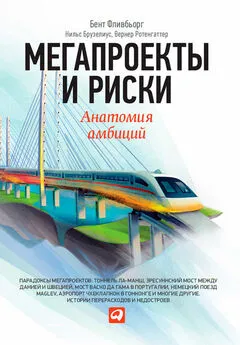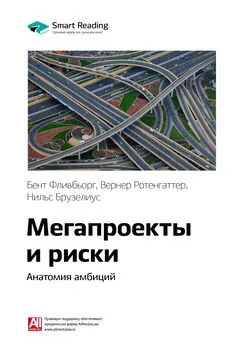Вернер Ротенгаттер - Мегапроекты и риски. Анатомия амбиций
- Название:Мегапроекты и риски. Анатомия амбиций
- Автор:
- Жанр:
- Издательство:Альпина Паблишер
- Год:2014
- Город:Москва
- ISBN:978-5-9614-3393-7
- Рейтинг:
- Избранное:Добавить в избранное
-
Отзывы:
-
Ваша оценка:
Вернер Ротенгаттер - Мегапроекты и риски. Анатомия амбиций краткое содержание
Мегапроекты и риски. Анатомия амбиций - читать онлайн бесплатно ознакомительный отрывок
Интервал:
Закладка:
153
Больше информации по экологическому мониторингу и контролю, см.: Ralf С. Buckley, “Environmental Audit: Review and Guidelines”, Environment and Planning Law Journal, том 7, № 2, июнь 1990 г., с. 127–41; Larry W. Canter, “The Role of Environmental Monitoring in Responsible Project Management”, The Environmental Professional, том 15, № 1, 1993, с. 76–87; Neil Gunningham, “Environmental Auditing: Who Audits the Auditors?”, Environmental and Planning Law Journal, том 10, № 4, 1993, с. 229–38; Helmut Karl, “Better Environmental Future in Europe Through Environmental Auditing?”, Environmental Management, том 18, № 4, 1994, с. 617–21; Dixon Thompson and Melvin J. Wilson, “Environmental Auditing: Theory and Applications”, Environmental Management, том 18, № 4, 1994, с. 605–15; Peter Bein and Mike Kawczynski, “Environmental Accounting Applied to Greater Vancouver Transportation System Planning”, paper presented to the 76th Annual Meeting of the Transportation Research Board (Washington, DC: Transportation Research Board, January 1997).
154
Wood, Dipper and Jones, “Auditing the Assessment of the Environmental Impacts of Planning Projects”, с. 46; Dipper, Jones and Wood, “Monitoring and Post-auditing in Environmental Impact Assessment: A Review”, с. 744.
155
В ряде недавних исследований, проведенных в США, Германии, Японии, Мексике, Швеции и Великобритании, говорится о выявленном значительном влиянии инфраструктурных инвестиций на развитие экономики вследствие сокращения издержек производства. См.: D. A. Aschauer, “Is Public Expenditure Productive?”, Journal of Monetary Economics, том 23, 1989, с. 177–200 and Aschauer, “Public Infrastructure Investment: A Bridge to Productivity Growth?”, Public Policy Brief 4 (Annandale-on-Hudson, NY: Bard College, Jerome Levy Economic Institute, 1993). Эти исследования были подвергнуты критике, поскольку они не показывали, действительно ли инвестиции в инфраструктуру привели к экономическому росту, а не наоборот, и поскольку другие факторы, которые могут вызвать и экономический рост, и инвестиции в инфраструктуру, не принимались во внимание. См.: World Bank, World Development Report 1994: Infrastructure for Development, с. 14–15. См. также Arturo Israel, “Issues for Infrastructure Management in the 1990s”, World Bank Discussion Papers, № 171, Washington, DC: World Bank, 1992. Как показывает Уинстон, результаты исследования 1989 г., проведенного Ашауером (Aschauer), нереалистичны, поскольку они предлагают соотношение затрат и выгод для инвестиций в инфраструктуру 10:1, а такой доход неправдоподобен и никогда не был зафиксирован в фактических оценках; Clifford Winston, “Efficient Transportation Infrastructure Policy”, Journal of Economic Perspective, том 5, № 1, зима 1991 г., с. 113–27. Утверждалось, что исследование Ашауера просто показывает, что кривые временной зависимости производительности и роста государственных инвестиций сходны – обе поднимались в 1950-х и 1960-х гг., и опускались в 1970-х и 1980-х гг., и что это соотношение вызывает сильно раздутые оценки дохода на государственные инвестиции в инфраструктуру; см.: Charles L. Schultze, “The Federal Budget and the Nation’s Economic Health”, in Henry Aaron, ed., Setting National Priorities: Policy for the Nineties (Washington, DC: Brookings Institution, 1990). Комплексный анализ дебатов и критики «макроэкономического подхода», представленного Ашауером, см.: Edward M. Gramlich, “Infrastructure Investment: A Review Essay”, Journal of Economic Literature, том 32, сентябрь 1994 г., с. 1176–96; см. также Damian J. Kulash, “Economic Returns from Transportation Investment”, Transportation Quarterly, том 51, № 3, лето 1997 г., с. 8–19.
156
Khan and Jomo, eds., Rents, Rent-Seeking and Economic Development: Theory and Evidence in Asia; Peter Boothroyd et al., “The Need for Retrospective Impact Assessment: The Megaprojects Example”, Impact Assessment, том 13, № 3, сентябрь 1995 г., с. 253–71.
157
Cm. Herbert Mohring, “Maximising, Measuring and Not Double Counting Transportation-Improvement Benefits: A Primer on Closed– and Open-Economy Cost-Benefit Analysis”, Transportation Research, B, том 27B, № 6, 1993, с. 413–24 and Curt Carnemark, Jaime Biderman and David Bovet, The Economic Analysis of Rural Road Projects, World Bank Staff Working Papers, no. 214 (Washington, DC: World Bank, 1984).
158
A. J. Venables and M. Gasiourek, “Evaluating Regional Infrastructure: A Computable Approach”, paper, London School of Economics, 1996.
159
Roger W. Vickerman, “The Channel Tunnel and Regional Development: A Critique of an Infrastructure-Led Growth Project”, Project Appraisal, том 2, № 1, март 1987 г., с. 38.
160
Ibid., с. 40.
161
Ibid.
162
Roger Vickerman, “Long Term Impacts of the Channel Tunnel: Methodology and Evidence”, paper for International Research Seminar on the Regional Development Impacts of the Øresund Bridge, Copenhagen, 28–29 ноября 1999 г., с. 11–12.
163
Danish Transport Council, “Regionaløkonomiske effekter af investeringer i trafikinfrastruktur: Notat til Trafikministeren”, in Danish Transport Council, Fire baggrundsnotater til trafik 2005, Notat no. 93:09 (Copenhagen; Transportrådet (Danish Transport Council), December 1993), с. 7. Два других отчета, выпущенных Транспортным советом Дании, содержат дополнительные данные по Дании и другим странам, имеющие отношение к теме этой главы: см. Anne-Mette Hjalager, “ Transportinfrastruktur og regional udvikling: Danske un dersøgelser”, Transportrådet, Notat no. 93:07 (Copenhagen: Transportrådet, December 1993); and Bjarne Madsen, Chris Jensen-Butler and Thomas Bue Вjørnег, Transportinfrastruktur og regional udvikling: Udenlandske undersøgelser, Transportrådet, Notat no. 93:06 (Copenhagen: December 1993).
164
Christian Wichmann Matthiesen and Åke E. Andersson, Øresundsregionen: Kreativitet, Integration, Vækst (Copenhagen: Munksgaard, 1993) and Den svenska Øresundsdelegationens Plan– och Miljögrupp, Øresundsforbindelser: Planerings– och miljöfrågor, DsK 1978:6, Stockholm: Den svenska Öresundsdelegation, 1978.
165
Matthiesen and Andersson, Öresundsregionen.
166
Henry Tordenström, Trafik– och näringslivseffekter av broar och andra trafiklänkar: Internationella erfarenheter av genomförda projekt (Malmö: Stadskontoret, 1991).
167
Koschatzky, “A River is a River: Cross-Border Networking Between Baden and Alsace”, с. 429–49.
168
Hjalager, Transportinfrastruktur, с. 6; David Hurdle, “Does Transport Investment Stimulate Economic Activity?”, The Planner, том 78, № 9, май 1992 г. См. также Geir Olav Ryntveit and Jon Inge Lian, Ringvirkninger av endret veitilgjenglighet, TØI-rapport 168, Oslo, n. p., 1993; Department of the Environment, Transport and the Regions, Transport and the Economy (London: Standing Advisory Committee on Trunk Road Assessment, 1999); Roger Vickerman, “Economic Impacts of Large Transport Infrastructure Projects”, paper for Symposium on Effects of a Maglev-Train Schiphol-Groningen, Groningen, 17 ноября 2000 г.
169
Cm. e. g. ibid., and Hurdle, “Does Transport Investment Stimulate Economic Activity?”
170
J. S. Dodgson, “Motorway Investment, Industrial Transport Costs, and Sub-regional Growth: A Case Study of the M62”, Regional Studies, том 8, 1973, с. 75–91. См. также Robert Cervero and John Landis, “Assessing the Impacts of Urban Rail Transit on Local Real Estate Markets Using Quasi-experimental Comparisons”, Transportation Research, Часть A, том 27A, № 1, 1993, с. 13–22; Sarah Stewart Wells and Bruce G. Hutchinson, “Impact of Commuter-Rail Services in Toronto Region”, Journal of Transportation Engineering, том 122, № 4, июль-август 1996 г., с. 270–5.
171
World Bank, World Development Report; Transportrådet, 1993, “Regionaløkonomiske effekter of investeringer…”, and Hjalager, Transportinfrastruktur. См. также Dieter Biehl, The Contribution of Infrastructure to Regional Development, Final Report, Infrastructure Study Group (Luxembourg: Commission of the European Communities, 1986).
172
J. Morlok, “Baden Airpark and its Importance for the High Technology Region of Karlsruhe”, paper presented at Seminar on Soft Factors in Spatial Dynamics, University of Karlsruhe, февраль 1998 г.
173
См. также David Lewis, “The Future of Forecasting: Risk Analysis as a Philosophy of Transportation Planning”, TR News, № 177, март 1995 г., с. 3–9; больше информации по проблеме прогнозирования эффективности; and Steven Schnaars, Megamistakes: Forecasting and the Myth of Technological Change (Нью-Йорк: Free Press, 1989).
174
В этой главе основной акцент делается на экономических и финансовых рисках. См. главу 5 относительно экологических рисков.
175
Введение в анализ риска, см.: David В. Hertz and Howard Thomas, Risk Analysis and Its Applications (New York: John Wiley & Sons Ltd, 1984); Dale Cooper and Chris Chapman, Risk Analysis for Large Projects: Models, Methods, and Cases (New York: John Wiley & Sons, 1987); M. Granger Morgan, Max Henrion and Mitchell Small, Uncertainty: A Guide to Dealing with Uncertainty in Quantitative Risk and Policy Analysis (Cambridge University Press, 1990); Savvakis Savvides, “Risk Analysis in Investment Appraisal”, Project Appraisal, том 9, № 1, март 1994 г., с. 3–18; Jaeger, Renn, Rosa and Webler, Risk, Uncertainty and Rational Action.
Читать дальшеИнтервал:
Закладка:










